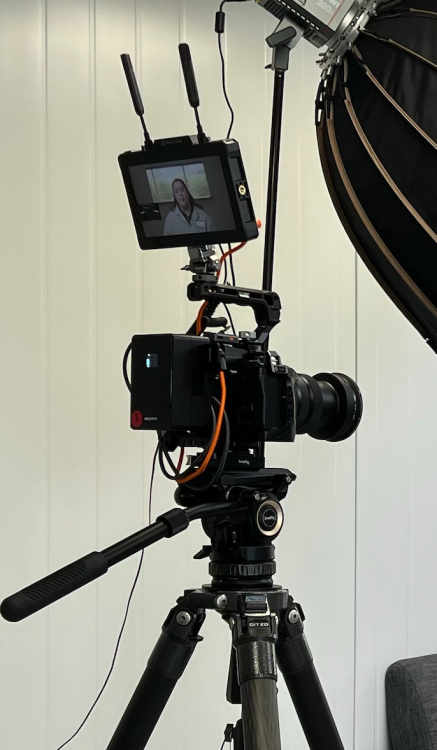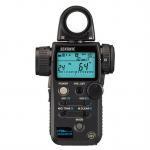All Activity
- Past hour
-
It's true, on it's own I think it's a fine camera and I've enjoyed it so far, but it is not a true replacement for the S1R, That camera felt much more elevated and bar non, one of my favourite so far!
- Today
-
Rich people do. "Buy when there's blood in the streets, even if the blood is your own."
-
 eatstoomuchjam reacted to a post in a topic:
New US camera import tariffs - 25-50%
eatstoomuchjam reacted to a post in a topic:
New US camera import tariffs - 25-50%
-
Sorry and thank you for the correction, yes the 24-70
-
 Andrew Reid reacted to a post in a topic:
New US camera import tariffs - 25-50%
Andrew Reid reacted to a post in a topic:
New US camera import tariffs - 25-50%
-
 OliveOliveOlive reacted to a post in a topic:
Anyone with a Panasonic S5 II or S9 interested in testing my in-cam ARRI compatible LOG C3 profile?
OliveOliveOlive reacted to a post in a topic:
Anyone with a Panasonic S5 II or S9 interested in testing my in-cam ARRI compatible LOG C3 profile?
-
 maxJ4380 reacted to a post in a topic:
Is DR that important?
maxJ4380 reacted to a post in a topic:
Is DR that important?
-
 John Matthews reacted to a post in a topic:
New US camera import tariffs - 25-50%
John Matthews reacted to a post in a topic:
New US camera import tariffs - 25-50%
-
 John Matthews reacted to a post in a topic:
New US camera import tariffs - 25-50%
John Matthews reacted to a post in a topic:
New US camera import tariffs - 25-50%
-
 kye reacted to a post in a topic:
The best film-making advice I ever got
kye reacted to a post in a topic:
The best film-making advice I ever got
-
I suspect i got caught up in some of that " instability " last week when the aus dollar did a pretty good impression of that last ship scene from the titanic... I had decided to purchase the reaper software that allows one to make music on a computer. I had been evaluating it for 360 days +. I just picked a bad day to buy it lol. US $66 went to $113 Australian, that's a nasty unexpected jolt to the system. It also makes me question further purchases when the US $ becomes involved. I haven't bought anything out of the US for the last few years as postage from the US is just astronomical and i have happy enough to source items from japan mostly. From now on, i personally will be thinking quite hard about any further purchases from abroad and that's lose / lose situation for everyone, i guess. On the upside i did find two smc takumars in an old camera bag up in the shed today. Which did brighten up my day a little.
-
The pakshi joined the community
-
Academized20 joined the community
-
So I got a chance to play with this today for a couple hours. My friend Zack bought it and has been using it for the last two weeks. He really likes it and from my limited time with it I too quite liked it. In the time I had with it it didn't overheat and Zack says he hasn't experienced overheating either. Mind you it's spring here in Vermont and the temperature today was 62 degrees (Fahrenheit) so I wouldn't expect it to. But I know some folks experienced overheating indoors in similar temperatures so I can't really say that it's not an issue, just that we recorded for about 80 minutes on an SD card and had no issue in that environment. I only filmed in 4K, as I'm not that interested in higher resolutions, so I can't really speak about anything else. Doing my own rolling shutter test (basically simulating how I'd film one of my sporting events) I found it to be more than acceptable. If you're whipping the camera around like a maniac I'm sure it stinks, but if you put even a little bit of effort into being steady it's really not an issue. Things I didn't like: I think the image is slightly better than the S5ii, but they're very close. I wish we could get something closer to the first generation of S cameras. Battery life is meh. While it didn't die it was very close, I think. I don't mind the body, but it doesn't feel very premium. I
-
 newfoundmass reacted to a post in a topic:
Panasonic Lumix S1R Mark II coming soon
newfoundmass reacted to a post in a topic:
Panasonic Lumix S1R Mark II coming soon
-
 newfoundmass reacted to a post in a topic:
Panasonic Lumix S1R Mark II coming soon
newfoundmass reacted to a post in a topic:
Panasonic Lumix S1R Mark II coming soon
-
 newfoundmass reacted to a post in a topic:
Panasonic Lumix S1R Mark II coming soon
newfoundmass reacted to a post in a topic:
Panasonic Lumix S1R Mark II coming soon
-
Industry and customers alike just love this kind of 💩 It’s worse than waiting each time for the next Lumix camera announcement and whether they even will or not… It’s called ‘instability’ and when times are not stable, no one spends any 💰
-
The 24-70, 28-70 or the new secret 27-70mm f1 lens? I have the not so secret 28-70 and think it’s a great lens; light, compact, minimal zoom extension.
-
AngelaTom joined the community
-
I'm running the camera and 7" Hollyland monitor off one V-mount, recording internally to a Lexar 512 silver CFexpress card. The camera battery is in the grip but fully charged. Camera is powered via usb-c and we are indoors so far about 20-21 C. The clips/takes are about 30 - 45 minutes each per interview. I *THINK* the overheating would be at extreme use, ( I have never had to shoot anything at 6k 60p or 120p in Pro Res HQ for 2 hours + in one take.....) but no issue so far with anything that I think is "normal" use!
-
Zegar6875 joined the community
-
Blackmagic Design, an Australia-based digital cinematography camera company, was gearing up to start making products in the United States before the Trump administration blew a tariff-shaped hole in its plans. Now, not only is Blackmagic having to increase prices in the US to mitigate some of the levies on imported goods, but those same tariffs are also making it difficult to justify opening a US production line. “We were planning to build a new factory in Dallas, Texas, to streamline our supply chain and allow us to work more directly with US semiconductor companies,” Blackmagic Design spokesperson Patrick Hussey told The Verge. The introduction and ever-shifting confusion around President Donald Trump’s blanket global tariffs have since complicated things according to Hussey, because while the semiconductor parts and PCBs used in Blackmagic’s cameras are sourced from US companies, those companies are importing them from overseas. “If we proceed with the US factory, we’d incur tariffs on those parts, increasing costs and negating the savings we anticipated,” said Hussey. It’s a no-win situation that many other businesses in and outside of the US are facing if they deal with global suppliers. While Trump has brazenly declared that tariffs will incentivize companies to bring manufacturing to the US to remain competitive, if these manufacturers use foreign equipment or materials in their supply chain, they may — directly or indirectly — still get hit with hefty import fees. (That’s leaving aside the cost of doing business when the fees change dramatically from day to day.) A supply chain survey conducted by CNBC found that 61 percent of respondents from unspecified businesses would be financially better off moving from high-tariff countries to lower-tariffed countries instead of the US, and 81 percent said if they did relocate to the US, they would automate production instead of hiring human workers, failing to deliver the manufacturing jobs Trump promised. 61 percent of the companies also warned they would raise prices for products coming in under the new tariff rates. Blackmagic Design customers have already noticed a price hike has been applied to all products sold in the US, with the new Pyxis 12K briefly listed at $6,600 after initially being marketed at $5,000. This has since fallen to $5,500 after Blackmagic announced it had moved Pyxis production to lessen the tariff impact, but prices in every country besides the US have remained completely unscathed. “Due to new government tariffs, price increases in the US have been unavoidable,” said Hussey. “That said, we operate factories in several countries, so production of some product lines has been relocated to reduce the impact on our customers.” Hussey told The Verge that Blackmagic is now planning to “wait a few months” to see if the supply chain for the components it needs will move to the US. “If it does, we could still achieve the supply chain benefits we were aiming for.” The Trump Administration added “smartphones, computers, and other electronics” to its list of tariff exemptions last week — a list with no clear carveout for cameras or camera-specific manufacturing equipment — but then swiftly warned that companies shouldn’t get comfy. Commerce Secretary Howard Lutnick said these are not “a permanent sort of exemption,” and that these goods will be hit with the same unspecified tariff rules that Trump is expected to apply to the semiconductor industry in “a month or two.” https://www.theverge.com/news/649225/blackmagic-design-trump-us-tariffs-price-hike
- Yesterday
-
This is reassuring! What was your setup - external power? external or internal recording? if internal, CFExpress or SD or both? HDMI monitoring? environment? All of this seems to conspire variably but I cannot bear to watch anymore on the interweb about this camera.
-
I'm going to keep this short as it's still early days. So far I've been very happy with my S1rii, the files (stills + Video) are really great, the C1 tethering (FINALLY) is great. It cuts with my two S5iix footage very nicely, and I haven't had a hint of overheating shooting 2+ hour talking head stuff, (4K 24 MOV) Battery hasn't been that bad or great for me! The RS is there if you move the camera very fast but nothing that I shoot requires that (YMMV). I can also report that the Sigma 27-70 L mount works perfectly on it, this is the first non brand L-mount on the Lumix for me and I had some concerns from reading some reports, but knock on wood, so far it's been fine! Overall, very happy so far.....
-
AlbertJoxia joined the community
-
Of course if you're a professional camera tester you'd think it's just dust, easy mistake to make!
-
I opened my box. I'm keeping mine & here's why: perhaps 80% of my income comes from clients that want a mix of still (heavy on the stills) and short video content. In this use case, the camera excels. It is very fast to use. A Panasonic that finally tethers to Capture One. Gorgeous, robust stills. Very good AF (although I am awaiting that first dimly-lit event). Fantastic IBIS in cropless mode - no more need to bring a gimbal for 60-90 second clips and walking shots (this was a serious knock against the Z8 for me). Nicely implimented, mid-range codec and the CineA2 is my new Eterna (when I don't want a Vlog workflow). Slightly better ergos and good in its own right mechanical shutter. I do not think I would keep this as a video-first camera body, which I think will doom it to irrelevance in this forum. I've had no issues in my limited time but the overheating that I am also reading about leaves a bad taste - more so than the rollign shutter concerns. I will experiment but for now, I wouldn't trust it filming 10-25 minute takes continuously over 2+ hours in a warm environment. Maybe 4k/24p would be ok and maybe all would be ok recording to an external SSD? A lot of variables would need to align. I also note the "crunchiness" from the S5II/x in the video - slight and I need to spend more time with it. @ita149 Any further insights re reducing NR in Vlog? Regardless, for client work, it will NOT be an issue and for flimmaking primarily, I'm keeping my S1. Some bitchy posters in other places were droning on and on about how it should have been named the S5RII. Well, bitchers be right. It's a good-feeling camera but it takes more from the S5 line that the S1 series for sure. Rather than an S-Pro lens, it feels more like the 20-60. @MrSMW The shutter is not that wonderfully damped shutter of the S1 but it is a significant improvement over the horrid clatch of the S5. I don't love it, but I'm comfortable with it. I greatly disliked the S5's ergos and the S5II/x was better. This is better still. Other than the weight, I love the S1 and the best feeling small body to me is the X-H2s. But this new camera is good, and I may get the grip to help that pitiful battery and for better support with larger lenses. But again, once I started working with the stills from yesterday's product shoot, no looking back.
-
Wide range of reports from folks in wedding videography forums especially. The overheating issue varies camera body to camera body and isn't always predictable. Not a good combination for wedding shooters. I don't shoot weddings anymore personally, but my gear needs closely align with wedding needs. Most importantly, I need to know I can hit record and walk away without fear of problems.
-
bullrun joined the community
-
Were there reports of it overheating beyond some reviewers finding that in the most taxing mode (6k open gate IIRC), it would overheat after more than an hour of continuous recording?
-
Jowenie joined the community
-
For (stills) photography, I actually calibrate my editing display so that its range is 0.4 to 90 nit. This matches approximately the contrast range of light reflecting from photographic prints. The display is capable of greater brightness and deeper blacks but I don't normally use that. If I use that display to view streamed video content, the limitation in dynamic range doesn't bother me (I'm not sure if the streaming actually follows the calibrated settings or go outside of it). The display has a "hood" which blocks stray light from the window and other parts of the room, so that avoids most of the reflections that might bother the viewing experience otherwise. I also have a TV which has an OLED screen and a very high contrast ratio (Sony xr-48a90k) and it gives a very high quality viewing experience. It takes into account ambient light brightness and adjusts the brightness and contrast to give an optimal experience in those conditions, so it works better than a projector when viewing during the day. The resolution is also very high, and the streaming applications adjust the TV settings to be optimal for the content they present. I think it's an amazing experience. I don't know what the actual contrast range of the display is (Sony says only that it's near infinite, marketing speak). Apple makes phone and computer screens with what they call Super Retina XDR where they claim the contrast range is 1000000:1 or something like that, but I don't know how accurate the claims are. That would be like 19 stops of dynamic range, if it is true. However, I suspect that kind of content dynamic range cannot be accurately seen in practice because of reflections from the display and also the viewing space. But, what these displays seem to give is a good viewing experience in varying ambient conditions. For stills photography, Adobe has some support for HDR images (I don't mean the usual way the HDR term is used in photography, where multiple exposures are tone-mapped to a result which displays well on SDR displays but actual support of HDR displays without tone mapping). However, the problem with this is that browser support is limited, and if you view a HDR image on an SDR display, you might get a distorted image that doesn't look correct. The Retina XDR display is amazing when viewing high scene contrast ratio photographs converted from RAW images for HDR viewing, it almost feels like a photo of a sunlit scene looks like you were viewing it in the location yourself. However, somehow software support needs to be developed so that both HDR and SDR versions of images can be distributed online and viewed according to the display that you have, since it's unlikely that all displays would be "real" HDR in the near future (increased power consumption etc.) I personally think the technology is amazing, but it's largely unnecessary and somewhat impractical (due to limiting the viewers that can see the images correctly). It seems HDR on the video side is more established and most TVs have some HDR capabilities, and the applications have some ability to adjust to the screen and ambient conditions for optimal experience (at least on my TV). So I would disagree that the displays don't exist, they do. But high dynamic range in cameras has uses also when producing content for SDR displays. On the stills side, people often make masks and dodge and burn the images to be able to get a more human-viewer-like experience within the limitations of SDR media such as SDR displays and prints. In video often there is the situation that you can't set up your own lights and the windows bring in bright daylight and you still have to be able to take video of people doing their activities indoors, hopefully without blowing out the windows. You can deal with this in post-processing somehow (I often reduce highlight contrast and lift the main subject up), or use in-camera tone-mapping techniques (such as Nikon D-Lighting). All of these approaches require a good dynamic range in the capture device to result in a low-noise image in the final result. In dimmer, artificial, lighting conditions when the daylight is gone, ideally one would not blow out the lights when the subject is correctly exposed, for a pleasing final result, again, log video here can help. If the purpose is just to make a video where the subject can be seen clearly and the functional purpose of the photography or video is satisfied, then most cameras made within the 15 years can easily suffice. However, often there are aesthetic objectives that go beyond just the functional information-transfer main goal, and these can be satisfied better with the newer tools.
-
Funnily enough, (not for the new owner, but it is/was MPB’s job to check any kit I sold them), I sent them a Fuji XH1 with the same damage. I was doing a shoot for a band in Spain and they had a laser set up and when I came back, the footage got increasingly bad with this weird blue and pink ‘bubblegum’ like blobs on every single piece of footage. It was a disaster 😱
-
I’m somewhat surprised about that as other than a faulty fan on a used S5ii (still didn’t overheat on a job!), I have not had a single issue in this regard with a Lumix camera in 3 years of pro use and often have units running in direct Summer sun with temps over 35 degrees C in the shade, so ‘god’ knows how hot in direct. I have melted long before any Lumix 🥵
-
There are better mirrorless video cameras for sure. I’d pick my S5ii’s without thinking about it. There are better hybrids; S1Rii, Z6iii, Z8, R5ii come to mind. But for stills, other than the Leica SL3 which beats it for design, build and badge, this side of medium format, I don’t think there is a better camera available today and at used prices… It’s hardly lacking in the video department and can shoot 8k but video is not its real strength. With a single prime or a small set (such as the Sigma contemporary line) in a small bag or a single or set of compact zoom lenses such as the Tamron’s, or even a lens such as Sony’s own 24-50 f2.8, it’s a bonkers good piece of kit. Compact but chunky, well built and with the best rear LCD in the business, for me and my needs, it’s that no-brainer they talk about. For most of this forum, maybe not. For the same money, I’d take the SL3 over it and maybe still if I could find one (doesn’t exist) at £3000, but beyond that, nope. I’ve flirted with the notion of medium format but Fuji does not have the lenses and Hasselblad is so far beyond my means, it might as well be one of those cameras on the moon. I’ve had quite a few Sony cameras over the years and admired a few, but none of them quite hit the spot. The A7RV is the first to do so and it’s only real fault for me is it doesn’t have a Lumix badge on it. (I like stuff to match).
-
Reviving the topic Most people talk about DR only as a camera parameter but you quite correctly understand it as a process Here is my answer: In short most of the time limiting part is the display (smartphone, computer, etc.) / theatrical screen or other media. Plus the color space in which we export. Camera DR is just one part of the puzzle. We have DR of: 1. The scene we are photographing or shooting in video. 2. The camera or recording device. 3. The medium that displays the recording being photographic paper or computer display or thearical screen or smartphone display. For point 1: A lot of times the scene has itself limited- dynamic range - 3-4-5 stops. For point 3: DR is related to the light intensity / brightness of the display medium. Traditional theatrical screens have only 100 nits of brightness and as result only 5-6 stops of DR. Traditional computer screens 300-400 nits which give us 6 to 7 stops of DR. Only HDR LCD screens and theatrical screens with laser projectors can show HDR video or imagery where color space allows for a wider dynamic range and medium is capable to reproduce this DR. In HDR video we can see up to 10 stops of DR. Since REC709 color space was introduced to deal with SDR TV screens it is also limited to 6-7 stops of DR. If we watch REC 709 footage on a HDR LCD screen we are still limited to those 6-7 stops. In this case limitation comes from the color space in which video has been exported. That's why a camera with limited DR - only 8 for LUMIX GH1 can look perfectly OK. In case exported footage is in REC709 it will need only 6-7 stops of DR. Where do the rest of camera DR go if we export in limited 6-7 stops of DR ? They are compressed / mapped to those 6-7 stops of the exported footage. Few more details in the shadows or highlights or both. Higher camera DR gives us more LATITUDE. You will often see latitude test go together with tests of for DR. Fuji Velvia which I used extensively in the past and was the top film emulation for landscape photography had only 6 stops of DR and 1/2 stop of latitude. If your photo was 1 stop underexposed or overexposed it was practically ruined. You have to wonder how people were able to shoot such a film and appreciate the results 🙂 When we talk about film DR we should always specify which emulsion we are have in mind. Now what happens when you have a scene with large dynamic range - 12-13 or more stops but your camera and / or export color space are limited to 7 ? Or you want to export in HDR (10 stops) but camera has only 8 stops. Some of the stops will be lost and the result will be lost details in the shadows or highlights. As one Hollywood colorist put it: "Your highlights are blown up? Who cares !!!" We don't watch a video or photograph like a scanning device from top to bottom, pixed by pixel. We look to a part of the photograph or video which is important and draws our attention. This part needs 5 stops DR to be displayed correctly and not always. 2 more stops for shadows and this is still enough for the vast majority of what we shoot and display. A limited dynamic range of the camera is not a problem as far as the important part of the scene is exposed and lighted correctly. More stops of camera DR gives us more LATITUDE and comfort in post production. Camera dynamic range becomes more important if we intend to export in HDR. That's all. In general DR and all technical aspects of picture quality fall under one philosophical category which I forgot the name: When contradicting statement about something are both true (correct): For example in this case: DR is important and DR is not important. Both are true. In practical terms ask yourself how many times you've heard somebody exiting a movies theater say: "Nice movie but I wish the DR was more " 🙂 On the other hand if we ignore those technical aspects we still will be stuck in black and white film emulsions with 5 stops of DR. Here is a great video from an Austrian photographer which goes into details about DR. It is by far the best explanation and structured answer about DR I've seen. Well worth your time: https://www.youtube.com/watch?v=uYOr6t8llgc And this one too: https://www.youtube.com/watch?v=aWGIjXutyKU
- Last week
-
Nope and I returned it. Panasonic's reliability has long been a reason I use them. The reports of overheating made this camera DOA for me. Maybe they'll sort it out in the future and I'll pick up a used one.
-
-
Canon price increases on all products coming within 2 weeks. https://www.canonrumors.com/price-increases-coming-from-canon-usa/ This will have a ripple effect too, on second hand prices globally. It might finally be time to stop buying shit.
-
The going rate for an a7R V in mint condition used is currently £2500 which is quite tempting.








